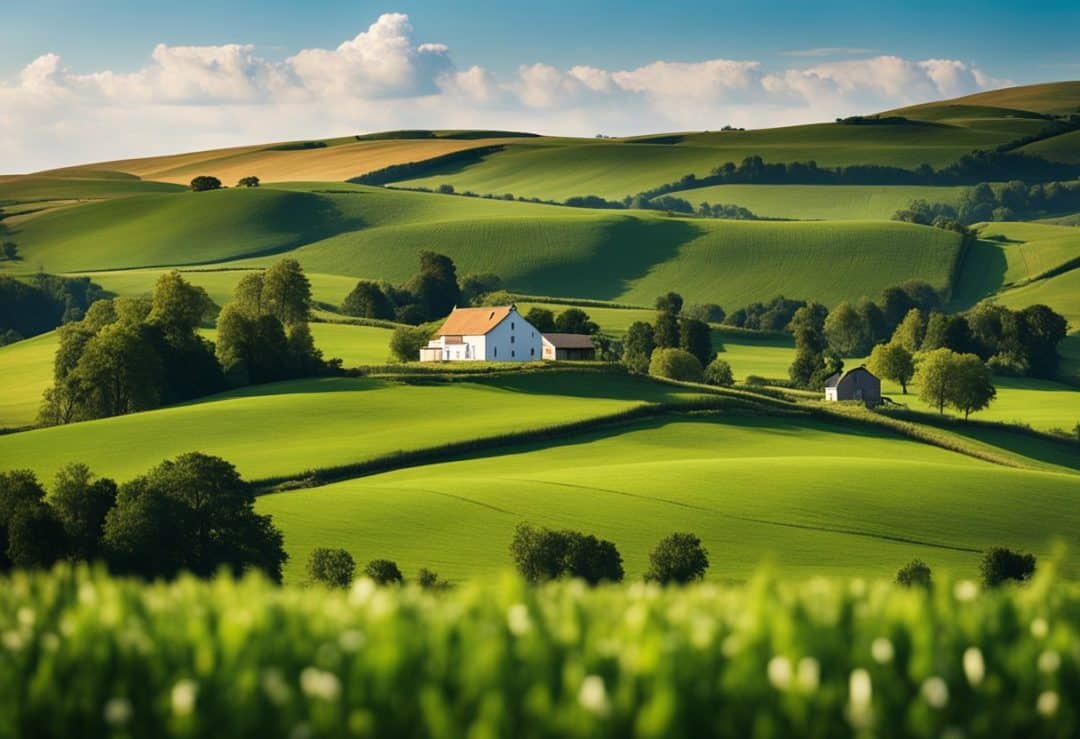As a farmer or someone living in the rural regions of New Zealand, staying informed about the weather is crucial for daily operations and long-term planning. With the unique and often unpredictable climate patterns here, it’s important to have access to detailed and accurate weather forecasts. This is where RuralWeather.co.nz comes into play, servicing the needs of those who feed the nation. Their comprehensive weather data, tailored towards rural communities, offers everything from up-to-the-minute forecasts to insightful long-range predictions.
Understanding weather changes is not only about watching the sky. For agricultural-focused communities, it involves being prepared for whatever Mother Nature throws their way, be it drought conditions, unexpected frosts, or heavy rainfalls that can impact crops and livestock. RuralWeather.co.nz provides an essential service by delivering specialized forecasts that address these concerns, employing state-of-the-art forecasting techniques that give rural communities the tools they need to respond effectively to changing weather patterns.
Key Takeaways
- RuralWeather.co.nz offers detailed weather information crucial for New Zealand’s farming and rural communities.
- Specialized forecasts help these communities prepare for and respond to various weather conditions.
- Advanced forecasting techniques and customized information make RuralWeather.co.nz a valuable resource for rural New Zealand.
Understanding Rural Weather in New Zealand

In my experience, understanding rural weather patterns is crucial for farmers and outdoor enthusiasts in New Zealand. Local knowledge plays a vital role in predicting weather events that affect these communities.
Climatic Zones and Variability
New Zealand’s landscape is highly diverse, which leads to multiple climatic zones existing throughout the country. I’ve noticed that in the North Island, the climate tends to be subtropical, characterized by humid weather, while the South Island experiences a temperate climate with colder winters. This variability can also result in different weather challenges for rural areas, ranging from frosts that can damage crops to droughts that may affect water supply. RuralWeather.nz stands out as a reliable platform offering in-depth local weather data, which is a game-changer for those who need to plan their agricultural activities according to the forecasts.
Seasonal Weather Patterns
Discussing seasonal weather patterns, New Zealand exhibits four distinct seasons. However, what’s fascinating about rural New Zealand is how each season can vary dramatically depending on your location. In spring, for instance, I find that frosts can still pose a risk to tender plants, while the summer might bring about dry spells particularly challenging for water management. To tackle these issues, websites like RuralWeather.nz provide detailed daily forecasts including rain radar and pressure maps, essential tools to help rural communities prepare for the weather ahead. They also offer insights into how the unique weather patterns of New Zealand, such as the notorious Roaring Forties winds, specifically affect rural regions.
Weather Forecasting Techniques

Experts in meteorology use a range of techniques to predict the weather. These approaches have evolved over time, incorporating traditional wisdom alongside cutting-edge technology.
Traditional Methods
Traditionally, weather forecasts relied on direct observations of the environment. Patterns in nature, such as cloud formations, wind direction, and even animal behavior, were all interpreted to predict changes in the weather. For instance, if cows are observed lying down in a field, it was often seen as a signal that rain may be on the way. RuralWeather.co.nz taps into this essence of historical patterns, sensitively applying them particularly in the farming context where traditional indicators can be crucial.
Modern Technology in Weather Prediction
Modern forecasting, however, utilizes sophisticated technology and data analysis. This includes satellite imagery, radar technology, and computer modeling to provide accurate and timely weather updates. With the incorporation of GPS for hyper-local forecasts and advancements in weather simulation models, RuralWeather.co.nz offers farmers and growers in New Zealand dynamic weather forecasts. Their service compares favorably to others by combining more forecast locations across the country. This helps the rural community prepare for potential weather-related challenges with fewer surprises. Their approach illustrates a successful blend of historical knowledge and modern science to keep communities informed and ready for whatever the weather holds.
Impact of Weather on Rural Communities

Weather plays a significant role in shaping the daily lives of rural communities. It affects food production, resource management, and the basic fabric of life for farmers and residents.
Agriculture and Farming
As someone who monitors and assesses weather patterns, I’ve seen firsthand how rural weather co nz provides farmers with detailed, localized forecasts. These forecasts enable farmers to make informed decisions regarding planting, harvesting, and protecting crops and livestock. For instance, if heavy rainfall is predicted, farmers can postpone plowing fields to prevent soil erosion. On the other hand, during drier seasons, the anticipation of rains will influence the timing of irrigation. Moreover, temperature fluctuations are critical for crop viability, and with the help of accurate weather data, rural communities can better plan and respond to frost events or heat waves which could otherwise devastate their yields.
Infrastructure Challenges
Robust infrastructure is the backbone of rural communities, yet it is often made vulnerable by severe weather events. Through information available on rural weather co nz, these communities can prepare and adapt their infrastructures, such as roads and drainage systems, for the forecasted conditions. For example, during times of expected heavy snowfall, preparations can be made to clear roadways and reinforce buildings against potential damage. This real-time data helps not only in immediate response strategies but also in long-term planning for infrastructure resilience against common issues like flooding and landslides associated with unpredictable weather patterns.
Preparedness and Response Strategies

Effective strategies for dealing with adverse weather involve meticulous planning and understanding specific safety measures tailored for rural environments.
Emergency Planning
I emphasize the importance of creating a comprehensive emergency plan that includes detailed steps for ensuring the safety of family, business, and livestock. Essential components of this plan involve emergency contacts, evacuation routes, and shelter plans for animals. It’s crucial to stay informed about potential government assistance that can provide support during climatic events and natural disasters affecting rural communities, like the information found on the Ministry for Primary Industries website. My plan integrates community resources and outlines clear roles and responsibilities for all family members and employees.
Key Elements of an Emergency Plan:
- Communication: Having a pre-arranged meeting point and a list of emergency contact numbers.
- Resources: Ensuring a stockpile of necessary supplies such as food, water, and medicine.
- Infrastructure: Regularly inspecting and maintaining buildings and utility systems to prevent weather-related damage.
Weather Safety Tips for Rural Areas
I recognize that staying ahead of the weather significantly reduces the risks associated with severe weather conditions. It’s important to consult reliable weather services and be aware of how to respond promptly to storms, as outlined on New Zealand’s National Emergency Management Agency’s page. Farmers and rural residents should:
- Secure loose objects that could cause damage in strong winds.
- Install and maintain proper drainage systems to prevent flood damage.
- Regularly check and fortify structures like barns, greenhouses, and storage sheds against severe weather impacts.
Moreover, I always recommend creating a ‘grab bag’ with essential items in case of a hasty evacuation and keeping emergency supplies, such as generators and sandbags, ready for immediate use.
Weather-Related Rural Events

Weather plays a pivotal role in the planning and success of outdoor rural events. It influences not only the attendance but also the activities that can be carried out during such gatherings.
Festivals and Fairs
In my experience, local festivals and fairs serve as cornerstones for community spirit, often scheduled during seasons that promise favorable weather. Take, for instance, the Autumn Harvest Festival in Feilding, where the sunny but cool temperatures add to the enjoyment of fall activities. The festival features:
- Pumpkin Picking: Guests select their perfect pumpkin from the patch.
- Hayrides: Tractor-drawn rides through scenic farm fields.
For details on weather forecasts crucial for these events, RuralWeather provides accurate forecasts for farmers and festival planners.
Seasonal Community Activities
Seasonal community activities are tightly interwoven with weather expectations. For example, the Spring Planting Day relies on post-winter warmth to ensure seeds have the right conditions for growth. During this day, community members typically engage in:
- Tree Planting: Enhancing community green spaces.
- Gardening Workshops: Educating on best planting practices.
Accurate weather information for these activities is essential and can be found through specialized rural weather services like MetService.
Long-Term Climate Trends

In New Zealand, there is clear evidence that our climate has been changing over the past century. This has led to noticeable shifts in how much rain we get in different places and the temperatures we experience during the year.
Changes in Rainfall Patterns
North Island and Upper South Island: Recent data suggests that there’s a trend toward drier conditions, especially in the eastern and inland areas. For instance, analysis from RuralWeather indicates that the North Island and upper South Island may experience increased dryness over time.
- Expected Rainfall Change: Forecasting tools predict a shift towards less rainfall than normal in these regions. This aligns with the prediction of a slide to an El Niño weather pattern, which typically brings less rain to the mentioned areas.
Temperature Fluctuations Over Time
Recorded data by NIWA shows that 2024 was the 10th-warmest year since records began in 1909 in New Zealand. This is part of a broader trend where annual temperatures have been consistently above average.
- Notable Temperature Anomalies:
- Northland
- Northern Waikato
- Bay of Plenty
These areas have experienced temperature anomalies between 0.51°C and 1.20°C above the annual average. The long-term data suggests a warming trend, underpinning that New Zealand isn’t immune to global warming. For more detailed statistics, NIWA provides an Annual Climate Summary for 2024, highlighting these trends.
Local Weather Resources and Services

I find that accurate weather forecasts are vital for daily planning, especially in rural regions. Below, I detail the role of local weather stations and the convenience offered by digital tools.
Rural Weather Stations
Weather stations scattered across rural areas are crucial. They provide real-time data on various weather elements. For instance, Midlands Rural Transport collects data from two local stations to give an overview of the area’s weather. Accurate and localized weather readings help farmers make informed decisions for their crops and livestock. These stations often measure:
- Temperature: Indicates the current warmth or coldness.
- Humidity: Affects soil moisture and crop health.
- Wind Speed: Influences soil erosion and spray applications.
- Precipitation: Critical for water supply and planning irrigation.
Online Tools and Mobile Apps
For convenience, online resources and mobile apps bring weather data straight to my fingertips. For detailed and hyper-local forecasts in New Zealand, the RuralWeather website backs farmers with comprehensive day and night predictions. They even have an app that alerts to changing weather conditions which can help users be prepared for unexpected weather events. Some key features of these online tools often include:
- Hourly Forecasts: Detailed short-term weather predictions.
- 10-Day Forecasts: Long-term planning for weather trends.
- Rain Radar: Visual representation of precipitation movement.
- GPS Functionality: Find forecasts for current locations.
Digital tools ensure that wherever I am, I can stay updated on the weather conditions that directly affect rural life and work.
Education and Community Outreach

I often engage with local communities to enhance understanding of meteorological phenomena and their impact on rural life. Through various initiatives, I aim to spread awareness and knowledge about weather patterns and their implications for the agricultural sector.
Workshops and Training Sessions
I conduct workshops and training sessions for farmers and growers. These programs are tailored to equip them with the skills necessary to manage weather-related challenges effectively.
- Seasonal Forecasting: Here, participants learn to interpret weather data to plan their farming activities better.
- Climate Resilience: I focus on strategies to strengthen farms against extreme weather events and climate change.
Each workshop is designed with practicality in mind, and I ensure that all attendees leave with actionable insights they can immediately apply to their operations.
School Programs and Youth Engagement
Engaging with the younger generation is essential for a sustainable future in agriculture. That’s why I’m involved in school programs aimed at students, introducing them to the science of weather and its role in food production.
- Hands-on Activities: I offer interactive sessions that allow students to learn through experience, such as building simple weather stations.
- Career Talks: By discussing my work and the importance of meteorology in agribusiness, I hope to inspire some to consider careers in this field.
These youth-oriented efforts help cultivate an early appreciation for the environment and underscore the critical connection between weather and rural communities.
Research and Innovations in Weather Science

Recent efforts have significantly improved our understanding of weather in rural areas and advanced our ability to predict it. These developments are particularly crucial for sectors like agriculture that rely heavily on accurate weather forecasts.
Recent Studies on Rural Meteorology
I’ve learned that rural meteorology has made leaps with new research, particularly in understanding how extreme weather affects less-populated regions. For example, an initiative was established to gather time-bound, evidence-based science services after extreme weather events impacted the North Island of New Zealand in 2023. This urgent scientific research and data collection has been essential in formulating rapid responses and aiding affected communities.
Another important work comes from NIWA, focusing on responding to and preparing for extreme weather events, which includes a series of projects that aim to assist communities to recover from the impacts of such events and brace for future ones.
Advancements in Prediction Models
Meteorological services have also made significant strides in improving weather prediction models. One key example is the integration of supercomputers in Numerical Weather Prediction (NWP), which has enhanced our ability to simulate New Zealand’s weather systems with high accuracy. The forecasting weather systems research by NIWA stands testament to this.
Furthermore, a unique partnership has emerged to boost the quality of weather forecasting for rural and regional New Zealand. The collaboration between MetService and HortPlus is a prime instance of how homegrown agri-tech solutions are being leveraged to improve rural weather forecasts, which is key for the agricultural sector’s planning and operations.
Environmental Conservation Efforts

I’m focusing on two specific ways to protect our environment in rural areas. The first is by using farming methods that lessen the impact of weather events. The second is through projects started by the people living in these areas.
Sustainable Practices to Mitigate Weather Impact
Farmers and land managers can play a crucial role in reducing the effects of extreme weather. By adopting sustainable practices, like optimized water use and soil management, these stewards of the land can help maintain the balance of our ecosystems. Techniques such as crop rotation, cover cropping, and reduced tillage contribute to soil health, which can make farms more resilient to drought and flooding. For example, keeping waterways clean is crucial for sustainable land and water use.
- Crop Rotation: Alternate the types of crops grown to improve soil fertility and reduce pests.
- Cover Cropping: Grow certain “cover” crops to prevent soil erosion and retain moisture.
- Reduced Tillage: Limit plowing to decrease soil disturbance, which helps preserve soil structure and biodiversity.
Community-Led Environmental Initiatives
Community-led projects can have a meaningful impact on local environments. Whether it’s tree planting drives or conservation workshops, these initiatives often provide education and resources that empower rural communities. Engaging with local schools and organizations creates awareness and encourages participation in conservation efforts. Education on climate change helps communities understand the significance of their actions and motivates them to act.
- Tree Planting: Increases green cover and helps in carbon sequestration.
- Conservation Workshops: Educate community members on local environmental issues and how to address them.
Case Studies and Success Stories

My research into the realm of rural weather and agriculture uncovers inspiring examples of resilience and innovation in disaster management and farming methodologies.
Effective Disaster Management Examples
Rangitata River Flood: In 2019, a large dairy operation situated on the south bank of the Rangitata River was hit by a significant flood. The event led to crucial insights into effective preparedness and response strategies for such events. The comprehensive case study by DairyNZ examined this natural disaster, focusing on the importance of emergency plans and community cooperation in minimizing the impact on farming operations.
Innovative Farming Techniques
Climate Change Mitigation: Many New Zealand primary producers are adopting sustainable practices to mitigate their impact on the environment. For instance, the use of native tree and grass riparian planting can reduce soil erosion. These practices also play a role in filtering pollutants from runoff and improving water quality. Detailed success stories and strategies can be found in the insightful mitigation approaches by Gordon Rajendram, which showcase native vegetation’s critical role in maintaining a healthy ecosystem.
Rainwater Harvesting Projects: Harvesting rainwater is another innovative technique that has seen success, providing cost savings and fostering environmental stewardship. By collecting and storing rainwater, farmers can improve water availability during dry periods. This leads to an overall boost in water security and sustainability. The top rainwater harvesting case studies offer a closer look at projects that implemented these systems effectively.
Frequently Asked Questions

In this section, I cover specific queries regarding rural weather in New Zealand, from forecasts for the next day to detailed weather patterns for the coming weeks.
What can I expect for rural weather conditions tomorrow?
Tomorrow’s rural weather conditions hinge on the current weather systems crossing the country. For the most accurate predictions, check RuralWeather’s website for the latest updates.
How can I track weather patterns over rural areas in New Zealand?
Tracking weather patterns over rural New Zealand is possible through specialized websites like RuralWeather, which offers detailed data and graphical representations of the weather.
Is there an application available for real-time rural weather updates in NZ?
Yes, there’s an app designed for real-time rural weather updates. To download the app and gain immediate weather alerts, visit the relevant RuralWeather download page.
What is the weather forecast for Wellington for the next 10 days?
The 10-day weather forecast for Wellington can be found on forecasting platforms. For more localized and agricultural-specific forecasts, RuralWeather provides an extended forecast.
Are hourly weather updates available for rural regions in New Zealand?
Hourly updates offer a more precise look at the weather conditions and are available. For graphical hourly forecasts, consult the RuralWeather graphs that provide hour-by-hour information.
What does the 14-day weather outlook show for Wellington?
For a 14-day weather outlook of Wellington, including trends and possible weather events, you can visit reputable local weather forecast websites. They offer comprehensive insights into expected weather patterns.





No Comments